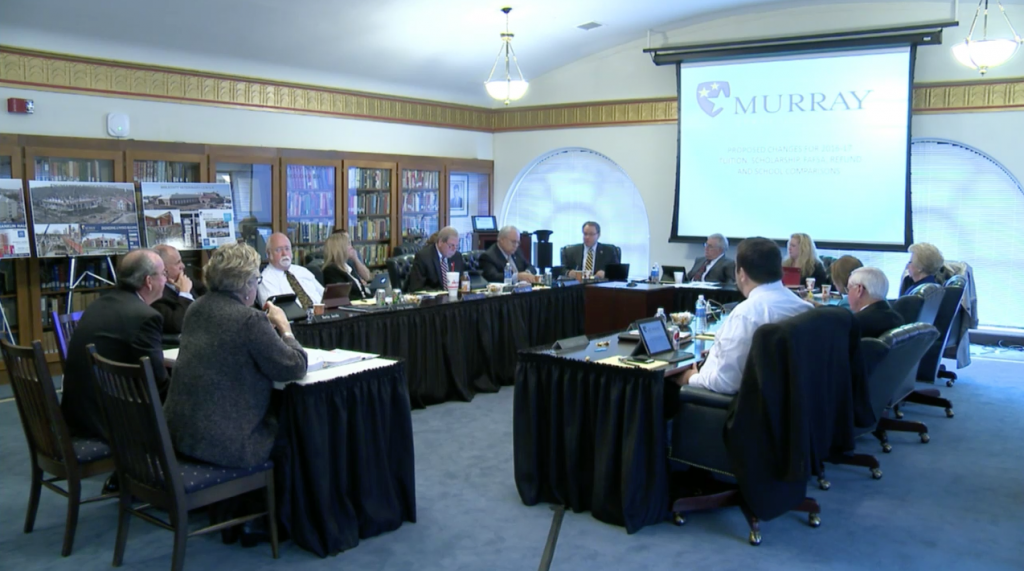Story by Mary Bradley, Editor-in-Chief, and Abby Siegel, Assistant News Editor
Many members of the Murray State Board of Regents said at Friday’s meeting that they believe it’s “realistic” to change the tuition structure so that students must pay per credit hour for each hour beyond a certain threshold in a semester.
“It’s very reasonable in trying to maintain the quality,” said Regent Jerry Sue Thornton. “Nobody likes to change tuition, but it’s realistic in this day and age.”
The proposed tuition plan had not been finalized, but options include having students pay for each credit they take beyond 12 or 15 hours. Students currently pay for up to 12 credit hours, and the university covers credit hours taken above that number.

The regents will vote on the new tuition plan at some point next semester with the latest possible date being the board’s quarterly meeting in June. If approved, the plan will move to the Kentucky Council of Post-Secondary Education for review and approval over the summer.
If approved by the Board of Regents and the CPE, the new tuition plan will be implemented beginning fall 2016 for newly enrolled students.
President Bob Davies said the proposed plan was “sustainable” and “competitive,” but also reflected the value of the institution. With state appropriations to universities more than 10 percent below 2005 levels, Davies said more of the funding burden has shifted to the students.
After failing to come to fruition in 2009, the proposed tuition change of charging by the hour beyond 12 or 15 credit hours is being tried again. Davies said it is a risk – but one that is essential in the continual growth of the university.
“The risk is greater to the institution if we do not take a step,” he said.
Yet, some regents said they had reservations.
Student Regent Clint Combs said some students have expressed concerns about programs that require students to take above 12 and 15 credit hours. He said music students and those in the Honors Program, for example, usually take several credits hours above 12 and 15 in order to complete their degrees on time.
At Friday’s meeting, Fred Dietz, vice president of enrollment management, and Jackie Dudley, vice president of finance and administrative services, also outlined for the regents other key points of the plan, such as the scholarship model, FASFA requirements and the number of credit hours students at which will begin to be charged.
While the proposed tuition model will allow scholarships to be flexible, it also will begin to require all students to fill out FASFA forms. Dietz said about 75 percent of students fill out the FASFA forms, but requiring all students to do so will help them access as much money as they can.
He said a common reason students do not fill out FASFA forms is because the process intimidates them, something he and others at the university will work to resolve.
Details about the proposed plan have been communicated to students who are looking to enroll for the fall. Davies said he and others at the university have held conversations and provided information about the proposed plan to potential students and their families so they were aware of possible changes.
APPROVING CHANGES
Also at Friday’s meeting, university officials offered reports regarding financial issues, enrollment and marketing campaigns.
The university had a clean general annual audit and was accepted by the Board of Regents. All audits were accepted, including WKMS, Athletics and Federal Funds.
According to the Buildings and Grounds committee, all construction projects are moving according to schedule. New buildings, such as New Franklin Residential College, will include features to help avoid water issues that have led to mold in the Biology and Chemistry building.
The committee recommended renovations to Winslow Dining Hall, including updated dish washing facilities, efficiencies in how the food is produced and how the food is served. These renovations would likely occur during summer of 2017 and would be about $2 million. The regents approved the recommendation and the design process will begin.
The Enrollment, Management and Student Success committee reported a decrease in overall student enrollment by 1.9 percent – the first decrease in about five years – lowering enrollment to just below 11,000 students. The previous academic year had the largest enrollment for the university of 11,207 students, likely because of the closing of Mid-Continent University.
Murray State saw a 6 percent decrease in international student enrollment likely because of some countries stopped sponsoring students coming to the United States and because of enrollment capping in certain graduate programs. Despite this, the university has its highest graduate level enrollment including the doctoral students.
The Marketing and Community Engagement committee reported on the new online calendar and its features, which will launch Jan. 8. The committee also reported on the Racer Holidays multimedia, crowd-funding campaign. The board also approved the naming of the WKMS operation center to Kate B. Lochte Transmission and Operations Center for her contributions to the station.
The Ad Hoc Presidential Compensation Review committee recommended a $2,000 addition to Davies’ compensation after reviewing other university presidents in Kentucky coupled with his work during his first year as university president.
Davies is the lowest paid president in Kentucky in terms of salary and is the only public university president the committee was aware of without a tax income differed plan. About $2,000 was added to Davies’ salary in order to make it tax neutral.
“I am very happy here at Murray State University,” Davies said. “To me, it is not all about the compensation.”
All regents voted in favor of these recommendations.



























































































